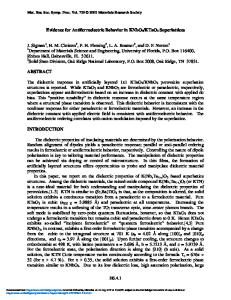Hydrothermal synthesis of KNbO 3 and NaNbO 3 powders
- PDF / 203,926 Bytes
- 8 Pages / 612 x 792 pts (letter) Page_size
- 33 Downloads / 455 Views
Sossina M. Haile Materials Science Department 138-78, California Institute of Technology, 1200 California Boulevard, Pasadena, California 91125
Carlos G. Levi Materials Department and Materials Research Laboratory, University of California, Santa Barbara, California 93106 (Received 22 July 2002; accepted 28 October 2002)
Orthorhombic KNbO3 and NaNbO3 powders were hydrothermally synthesized in KOH and NaOH solutions (6.7–15 M) at 150 and 200 °C. An intermediate hexaniobate species formed first before eventually converting to the perovskite phase. For synthesis in KOH solutions, the stability of the intermediate hexaniobate ion increased with decreasing KOH concentrations and temperatures. This led to significant variations in the induction periods and accounted for the large disparity in the mass of recovered powder for different processing parameters. It is also believed that protons were incorporated in the lattice of the as-synthesized KNbO3 powders as water molecules and hydroxyl ions.
I. INTRODUCTION
KNbO3 is a promising material for electro-optic, nonlinear optical, and photorefractive applications such as frequency doubling, wave guiding, and holographic storage.1–3 In conventional, solid-state synthesis of KNbO3 using mixed powders, prolonged heating at a high temperature (820 °C) is required.4 More recently, KNbO3 has been synthesized by the sol-gel method in which alkoxide precursors are used to produce an amorphous gel that is calcined at 600 °C to remove the organic components of the gel and to yield crystalline KNbO3.5,6 An aqueous solution route has also been used to precipitate amorphous KNbO3 powders at 25 °C, which is then crystallized by heating to 600 °C.7 In contrast, crystalline KNbO3 powders can be synthesized by the hydrothermal method at temperatures below 200 °C.8,9 Unlike BaTiO3, the hydrothermal synthesis of KNbO3 powders has not been extensively investigated. Komarneni and co-workers8 reported that KNbO3 could be synthesized at 194 °C by reacting Nb2O5 in a solution containing 3 M OH− and 9 M K+ while Uchida et al.10 reported using 3 M KOH at 250 °C. Lu et al. obtained
a)
Address all correspondence to this author. Present address: Institute of Materials Research and Engineering, 3 Research Link, Singapore 117602, Republic of Singapore. e-mail: [email protected]
338
http://journals.cambridge.org
J. Mater. Res., Vol. 18, No. 2, Feb 2003 Downloaded: 10 Mar 2015
orthorhombic KNbO3 (the stable form) by reacting Nb2O5 with 8 M KOH at 200 °C and observed that the crystal structure became cubic with increasing niobium concentration in the solution.9 Both Komarneni et al.8 and Lu et al.9 noticed large variations in the amount of powder recovered for different KOH concentrations. Lu et al.9 qualitatively described the amount of recovered powder with terms such as a large amount when using 8 M KOH, a small amount when using 6 M KOH, and no precipitates when 4 M KOH was used. (The comparisons were made for synthesis at 200 °C after 2 h with 0.1 M of Nb2O5 powder.) NaNbO3 is antiferroelectri
Data Loading...











